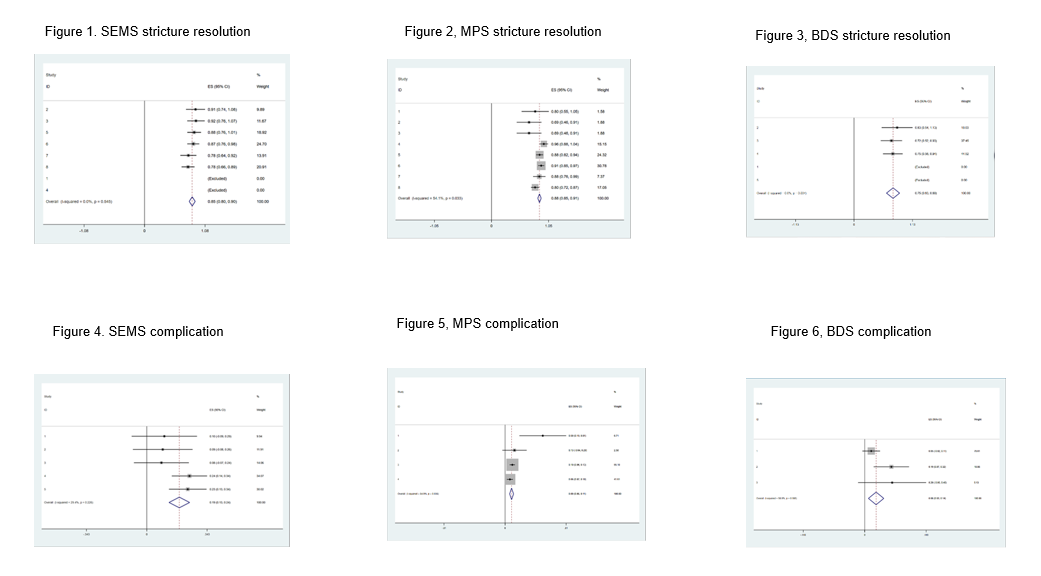A Meta-Analysis of Endoscopic Stents in the Treatment of Anastomotic Biliary Strictures After Liver Transplantation
F. Zhou1, M. Mieth1, C. Rupp2, A. Mehrabi1, A. Nickkholgh1
1Department of General, Abdominal and Transplant Surgery, University of Heidelberg, Heidelberg, Germany, 2Department of Internal Medicine, University of Heidelberg, Heidelberg, Germany
Meeting: 2021 American Transplant Congress
Abstract number: 334
Keywords: Liver transplantation, Meta-analysis, Post-operative complications
Topic: Clinical Science » Liver » Liver: Retransplantation and Other Complications
Session Information
Session Name: Post Liver Transplant Management and Complications
Session Type: Rapid Fire Oral Abstract
Date: Tuesday, June 8, 2021
Session Time: 4:30pm-5:30pm
 Presentation Time: 4:30pm-4:35pm
Presentation Time: 4:30pm-4:35pm
Location: Virtual
*Purpose: Biliary strictures (BS) are common after orthotopic liver transplantation (OLT). The treatment of choice is endoscopic retrograde cholangiopancreatography (ERCP). Multiple plastic stents (MPS) have been widely; covered self-expandable metallic stents (SEMS) have been invented subsequently to reduce the need for stent replacements and to reduce the intervention times. Biodegradable stents (BDS) have been recently introduced. Few studies have included the comparison of all three modalities. This study aims to compare results from the use of MPS and BDS to treat BS after OLT to recent outcomes after BDS.
*Methods: PUBMED and EMBASE databases. Search for available RCTs and clinical trials to compare the efficacy and safety of MPS, SEMS and BDS in ABS after orthotopic liver transplantation(OLT). Primary outcomes were the resolution, and the recurrence of BS, while secondary outcomes were adverse events and number of procedures performed. Pooled estimates were calculated using random-effects models.
*Results: Seven studies (481 patients) included the comparison between MPS (184 patients) and SEMS (297 patients). There was no significant difference between MPS and SEMS regarding BS resolution (OR=0.97, 95%CI: 0.59-1.58, p=0.91), recurrence (OR=1.17, 95%CI: 0.50-2.74, p=0.73), successful treatment with initial protocol (OR=1.69, 95%CI: 0.85-3.39, p=0.14). SEMS reduced the number of ERCP sessions needed to achieve stricture resolution ( p<0.0001). SEMS, however, had significantly higher complications during treatment (OR=2.3,95%CI:1.41-3.75, p=0.0009). Only four descriptive studies were found using BDS on total of 55 patients to treat BS after OLT with no control group. Using Stata software comparison,the stricture resolution rate in BDS seems to be lower compared to both SEMS and MPS groups (Figure1-3), with lower rate of complication compared SEMS and MPS (Figure 4-6).
*Conclusions: Compared to MPS,SEMS provides shorter operation time and similar success rate,reducing the number of ERCP session to achieve stricture resolution, but have higher complication rate during treatment. BDS seems to have lower stricture resolution rate and complication rate during treatment than SEMS and MPS.
To cite this abstract in AMA style:
Zhou F, Mieth M, Rupp C, Mehrabi A, Nickkholgh A. A Meta-Analysis of Endoscopic Stents in the Treatment of Anastomotic Biliary Strictures After Liver Transplantation [abstract]. Am J Transplant. 2021; 21 (suppl 3). https://atcmeetingabstracts.com/abstract/a-meta-analysis-of-endoscopic-stents-in-the-treatment-of-anastomotic-biliary-strictures-after-liver-transplantation/. Accessed December 19, 2025.« Back to 2021 American Transplant Congress

